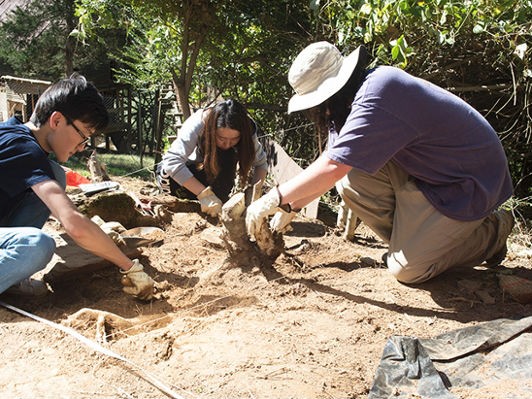A 170-year-old grist mill in Hall County and a structure key to Lumpkin County's gold-mining history are among the area sites where archaeology students at the University of North Georgia are working to uncover history in order to help preserve it.
Head's Mill, also known as Healan's Mill, near Lula, fell into disrepair decades ago and is Hall County's last standing grist mill. The Head's/Healan's Mill Restoration Citizens Advisory Committee and the Hall County government have teamed to restore the site. This fall, UNG students led by Dr. William Balco, assistant professor of anthropology at UNG, worked at the site to better understand how the grain mill and its three-story water wheel operated.
"UNG has taken on a role in this restoration, where we're doing the archaeology where we can," Balco said. "This grist mill was one in which a large water wheel would be turned not by the flow of the water, but the weight of the water that would pull the wheel and spin it. That would turn the axles attached to the mill wheels and that's how they would grind the grain. UNG students investigated a site at the head of the millrace to uncover the mechanism that controlled the flow of water toward the wheel."
Involved in the projects is Matthew O'Leary, a senior from Torrington, Connecticut, who is pursuing a major in history and a minor in anthropology.
"One of the reasons I really appreciate working on local sites like Healan's Mill is that these types of projects help remind us that history is around all of us, even where we might often overlook it," O'Leary said.
This fall, O'Leary received a Georgia Student Archaeological Research Grant for $375 that will help with archival and photographic expenses associated with investigating the Yahoola High Trestle, a structure constructed to transport water to hydraulic mining operations during Dahlonega's gold rush period.
Co-sponsored by the Georgia Department of Natural Resources and the Georgia Council of Professional Archaeologists, the grant is given annually to one graduate student and two undergraduate students in Georgia to fund their research.
"Receiving this grant from the Society for Georgia Archaeology is an incredible opportunity to further the study of our local Dahlonega mining history," O'Leary said. "The goal of this project will be to locate the extent of the ditch and trestle system in Dahlonega and Lumpkin County and collate the data onto a single map."
O'Leary said he is considering graduate school upon completion of his undergraduate degree at UNG.
The anthropology minor at UNG has grown steadily since its establishment in 2014. The program, which is available on both the Dahlonega and Gainesville campuses, offers upper-level classes such as Anthropology of the Middle East, Museum Studies, Anthropology of Food, Biblical Archaeology, and Battlefield Archaeology.
In addition to the local projects, this coming summer, several students will also participate in a dig near Alcamo, Sicily.

http://accesswdun.com/article/2016/12/476384/ung-students-helping-discover-preserve-regions-history
